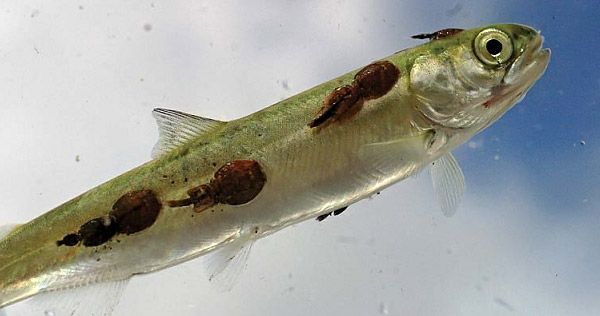vendredi 29 août 2014
mardi 19 août 2014
Parasite of the month
Lepeophtheirus salmonis
Salmon lice are parasitic copepods that feed on the skin and blood of salmonids. Over their life-cycle, they alternate between free-swimming, stationary and mobile life-styles. They attach to salmonids during the thrids life stage and grow up to 12mm for adults females (30mm with egg strings) and 6mm for adult males. Mean generation time is about 6 weeks at 12°C.

In small amounts, lice cause little damage to the fish but high intensities of infection can reduce growth and even lead to death of the host. Symptoms include skin erosion, constant bleeding and open wounds, which can facilitate infections by pathogens. Moreover, salmon lice are also vectors of a few pathogens, such as infectious salmon anemia.
In the recent years, their numbers have been increasing due to the growth of the aquaculture industry. High densities of hosts at fish farms was shown to increase transmission and to trigger the evolution of higher virulence of L. salmonis, as discussed in Mennerat et al. (2012 J. Evol. Biol.). This can have dramatic consequences for wildlife as (1) infestations of sea lice in salmon farms increases the number of lice in the rest of the surrounding water and because (2) lice act as a vector for diseases between wild and farmed salmon, affecting the evolution of virulence of parasites of wild fish.
Recently, a study by Losos et al. (2010 Behaviour) found stickleback to feed on female salmon lice - towards new management practices at fish farms?
(source for picture: http://www.bears-and-more.de/grafiken/2010-12-03_1.jpg)

In small amounts, lice cause little damage to the fish but high intensities of infection can reduce growth and even lead to death of the host. Symptoms include skin erosion, constant bleeding and open wounds, which can facilitate infections by pathogens. Moreover, salmon lice are also vectors of a few pathogens, such as infectious salmon anemia.
In the recent years, their numbers have been increasing due to the growth of the aquaculture industry. High densities of hosts at fish farms was shown to increase transmission and to trigger the evolution of higher virulence of L. salmonis, as discussed in Mennerat et al. (2012 J. Evol. Biol.). This can have dramatic consequences for wildlife as (1) infestations of sea lice in salmon farms increases the number of lice in the rest of the surrounding water and because (2) lice act as a vector for diseases between wild and farmed salmon, affecting the evolution of virulence of parasites of wild fish.
Recently, a study by Losos et al. (2010 Behaviour) found stickleback to feed on female salmon lice - towards new management practices at fish farms?
(source for picture: http://www.bears-and-more.de/grafiken/2010-12-03_1.jpg)
Inscription à :
Articles (Atom)